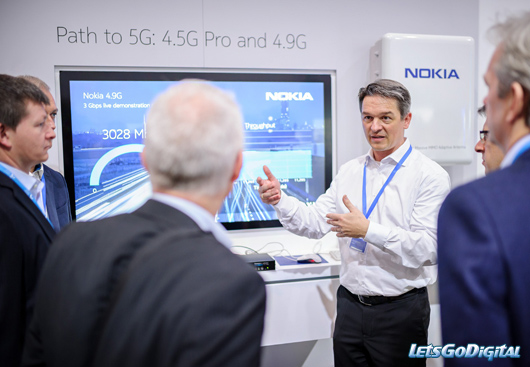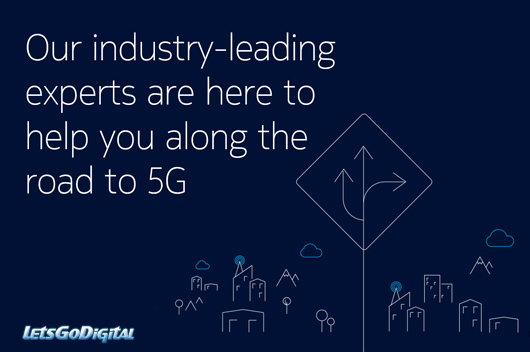Mark Peters : March 5th 2017 – 10:00 CET
|
 Nokia Internet of things and Cloud services : Nokia outlined how the rapid execution of its new strategy is delivering industry-leading innovation for communication service providers in network speed, agility and efficiency, while broadening the company’s footprint in faster-growing areas including software and the utilities and transport markets. On the eve of Mobile World Congress in Barcelona, Nokia’s launches of solutions covering 5G, the Internet of Things (IoT), software and cloud underscored the breadth and strength of a product portfolio bolstered by the acquisition of Alcatel-Lucent in 2016. New products like 5G First, announced at the company’s international press event in Spain, show Nokia’s innovation strength to deliver innovative products that connect not only millions of users but interconnect billions of things to create what Nokia calls the global nervous system. Nokia Internet of things and Cloud services : Nokia outlined how the rapid execution of its new strategy is delivering industry-leading innovation for communication service providers in network speed, agility and efficiency, while broadening the company’s footprint in faster-growing areas including software and the utilities and transport markets. On the eve of Mobile World Congress in Barcelona, Nokia’s launches of solutions covering 5G, the Internet of Things (IoT), software and cloud underscored the breadth and strength of a product portfolio bolstered by the acquisition of Alcatel-Lucent in 2016. New products like 5G First, announced at the company’s international press event in Spain, show Nokia’s innovation strength to deliver innovative products that connect not only millions of users but interconnect billions of things to create what Nokia calls the global nervous system. |
|
Nokia 5G network technology Nokia 5G First, the industry’s first commercial 5G product and comprised of Nokia’s Air-Scale radio access platform, helps customers prepare for 5G network architectures that cover core, software-defined networking, cloud and more. Nokia and Intel will collaborate on commercial deployments later in 2017 using the Intel 5G Modem. 5G First cements Nokia’s strong position with communication service providers, helping them transition to new applications that will benefit from the low-latency and high data rates offered by 5G. Reflecting those transition efforts, Suri announced at the press and analyst event that Nokia had won a three-year contract from Telefonica to boost the performance of its 4G network in London as data demand grows. The deal includes Nokia 4.5G Pro technology, powered by the Nokia AirScale Radio Access portfolio, Nokia Flexi Zone small cells, the Nokia NetAct network management system, Nokia Traffica real-time network analytics and Nokia Global Services.  Worldwide IoT network grid Nokia’s recent launch of WING, the worldwide IoT network grid, is aimed at providing a full-service model offering IoT connectivity across different technologies to manage a client’s IoT connectivity needs and assets, such as connected cars, as they move around the globe. It follows the launch of a new wireless router to bring electricity distribution networks into the IoT era and help utilities reliably and securely connect and manage the proliferation of field devices as more smart power grids are deployed. Those efforts show how Nokia is expanding into vertical markets like energy, transportation, public safety and Webscales (big Internet companies). Furthering the momentum in the vertical space, Suri cited a contract win with Infraestruturas de Portugal to provide a mission-critical communications network to the country’s national railway infrastructure operator; a high-speed fiber optic network win with Xiaomi; and a demonstration with Qualcomm and GE of a private LTE network for the Industrial Internet of Things market.  Nokia Internet of things solutions Nokia’s recently launched Cloud Packet Core enables fixed and wireless technologies to be used together or individually to drive ultra-broadband and Internet of Things service delivery in multiple verticals, including enterprise. Nokia has also enhanced its Intelligent Management Platform for All Connected Things platform, or IMPACT, with new IoT features such as video analytics. The improved offering highlights Nokia’s progress in delivering on its third strategic focus area of building a strong standalone software business and taking its largely network-agnostic software assets beyond mobile customers and into fixed, cable, and new vertical markets. Earlier this month, Nokia announced plans to buy Comptel to boost its software portfolio and go-to-market capabilities.  Deepfield analytics technology At 2017 Mobile World, Nokia has demonstrated recently acquired Deepfield analytics technology, which further bolsters its software offering to communication service providers, cable operators, cloud, Webscales and technological extra-large enterprises. Using automation, Deepfield technology can identify and track popular cloud applications and services to help networks quickly adapt to changes in application demand and traffic patterns. Nokia’s efforts to create new business and licensing opportunities in the consumer space – the fourth pillar of its refreshed strategy – are also leading to fresh and important developments. |
![]()
![]()
![]()
![]()
![]()
![]()